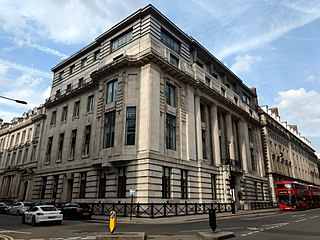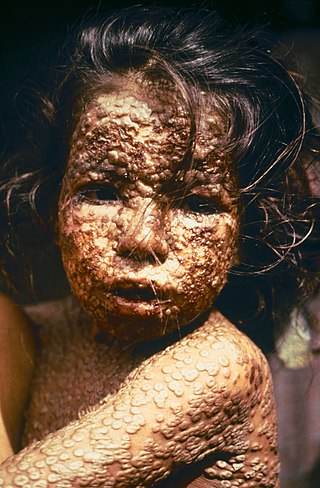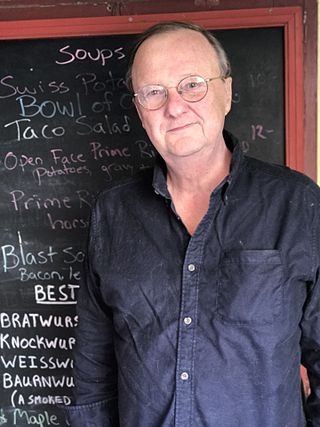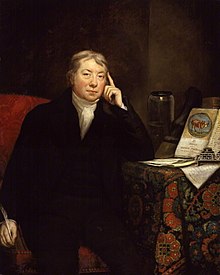
Edward Jenner, was an English physician and scientist who pioneered the concept of vaccines and created the smallpox vaccine, the world's first vaccine. The terms vaccine and vaccination are derived from Variolae vaccinae, the term devised by Jenner to denote cowpox. He used it in 1798 in the title of his Inquiry into the Variolae vaccinae known as the Cow Pox, in which he described the protective effect of cowpox against smallpox.

The smallpox vaccine is the first vaccine to have been developed against a contagious disease. In 1796, British physician Edward Jenner demonstrated that an infection with the relatively mild cowpox virus conferred immunity against the deadly smallpox virus. Cowpox served as a natural vaccine until the modern smallpox vaccine emerged in the 20th century. From 1958 to 1977, the World Health Organization (WHO) conducted a global vaccination campaign that eradicated smallpox, making it the only human disease to be eradicated. Although routine smallpox vaccination is no longer performed on the general public, the vaccine is still being produced to guard against bioterrorism, biological warfare, and mpox.

Epidemiology is the study and analysis of the distribution, patterns and determinants of health and disease conditions in a defined population.

Charles Louis Alphonse Laveran was a French physician who won the Nobel Prize in Physiology or Medicine in 1907 for his discoveries of parasitic protozoans as causative agents of infectious diseases such as malaria and trypanosomiasis. Following his father, Louis Théodore Laveran, he took up military medicine as his profession. He obtained his medical degree from University of Strasbourg in 1867.

Donald Ainslie Henderson was an American medical doctor, educator, and epidemiologist who directed a 10-year international effort (1967–1977) that eradicated smallpox throughout the world and launched international childhood vaccination programs. From 1977 to 1990, he was Dean of the Johns Hopkins School of Public Health. Later, he played a leading role in instigating national programs for public health preparedness and response following biological attacks and national disasters. At the time of his death, he was Professor and Dean Emeritus of the Johns Hopkins Bloomberg School of Public Health, and Professor of Medicine and Public Health at the University of Pittsburgh, as well as Distinguished Scholar at the UPMC Center for Health Security.

The Royal Society of Medicine (RSM) is a medical society based at 1 Wimpole Street, London, UK. It is a registered charity, with admission through membership.

The Epidemic Intelligence Service (EIS) is a program of the U.S. Centers for Disease Control and Prevention (CDC). The modern EIS is a two-year, hands-on post-doctoral training program in epidemiology, with a focus on field work.

William Herbert Foege is an American physician and epidemiologist who is credited with "devising the global strategy that led to the eradication of smallpox in the late 1970s". From May 1977 to 1983, Foege served as the Director of the Centers for Disease Control and Prevention.
Abram Salmon Benenson was an authority in public health, preventive medicine, military medicine, and "shoe-leather" epidemiology. He was best known as the editor-in-chief for the Control of Communicable Diseases Manual of the American Public Health Association. His tenure as editor was so lengthy that the manual was often known as the "Benenson Book".
David L. Heymann is an American infectious disease epidemiologist and public health expert, based in London.
Genetic epidemiology is the study of the role of genetic factors in determining health and disease in families and in populations, and the interplay of such genetic factors with environmental factors. Genetic epidemiology seeks to derive a statistical and quantitative analysis of how genetics work in large groups.

Smallpox was an infectious disease caused by variola virus which belongs to the genus Orthopoxvirus. The last naturally occurring case was diagnosed in October 1977, and the World Health Organization (WHO) certified the global eradication of the disease in 1980, making smallpox the only human disease to be eradicated.
The American Journal of Epidemiology (AJE) is a peer-reviewed journal for empirical research findings, opinion pieces, and methodological developments in the field of epidemiological research. The current editor-in-chief is Dr. Enrique Schisterman.
Clinical epidemiology is a subfield of epidemiology specifically focused on issues relevant to clinical medicine. The term was first introduced by Jean Paul in his presidential address to the American Society for Clinical Investigation in 1938. It is sometimes referred to as "the basic science of clinical medicine".
Karel Raška was a Czech physician and epidemiologist, who headed the successful international effort during the 1960s to eradicate smallpox.
The Epidemiological Society of London was a British medical society founded in 1850 with the objective of investigating the causes and conditions which influence the origin, propagation, mitigation, and prevention of epidemic disease. In 1907 it merged with the Royal Medical and Chirurgical Society of London and became a part of the Royal Society of Medicine as the Epidemiological Section.
The Milroy Lectures are given on topics in public health, to the Royal College of Physicians, London. They were set up by money left by Gavin Milroy, who died in 1886.

John S. Marr is an American physician, epidemiologist, and author. His professional life has concerned outbreaks of infectious disease and thus his subsequent writing career has focused on that topic, particularly historical epidemics.

Michael Joseph Ryan is an Irish epidemiologist and former trauma surgeon, specialising in infectious disease and public health. He is executive director of the World Health Organization's Health Emergencies Programme, leading the team responsible for the international containment and treatment of COVID-19. Ryan has held leadership positions and has worked on various outbreak response teams in the field to eradicate the spread of diseases including bacillary dysentery, cholera, Crimean–Congo hemorrhagic fever, Ebola, Marburg virus disease, measles, meningitis, relapsing fever, Rift Valley fever, SARS, and Shigellosis.

The Weekly Epidemiological Record (WER) is a publication of the World Health Organization (WHO) that as of 2020 is in its 95th volume. It is published in English and French with the alternative title of the Relevé épidémiologique hebdomadaire. It aims to rapidly disseminate epidemiological information about outbreaks of diseases under the International Health Regulations and about communicable diseases of public health importance. This includes emerging or re-emerging diseases.












